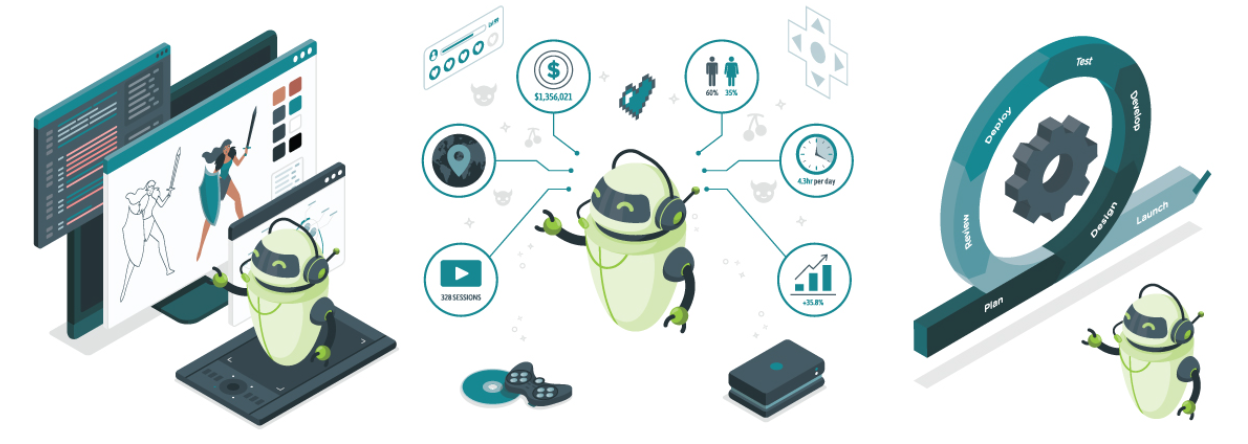 GAME TESTING
GAME TESTING Software Quality Assurance in Gaming: Ensuring Excellence in Digital Entertainment

Introduction
The gaming industry has seen exponential growth, transforming from simple 8-bit experiences to vast, immersive worlds. This evolution has heightened the demand for high-quality gaming experiences, where bugs, glitches, and performance issues can tarnish a game's reputation. Software Quality Assurance (SQA) in gaming has become a critical component, ensuring that games meet the high standards expected by players worldwide.
The Importance of SQA in Gaming
Quality assurance in gaming is more than just bug fixing; it's about delivering a seamless, enjoyable experience. Here are some key reasons why SQA is vital:
1. Player Experience: A single bug can ruin the immersion and enjoyment for players. SQA ensures that gameplay is smooth, intuitive, and free from disruptive issues.
2. Reputation: A game's reputation can make or break its success. High-quality games build trust and loyalty among players, leading to better sales and positive reviews.
3. Financial Impact: Bugs and glitches can lead to costly post-release patches and damage control. Investing in SQA upfront can save significant costs in the long run.4. Security: Games often involve online interactions and transactions. SQA helps safeguardplayer data and prevent cheating or hacking.
The SQA Process in Gaming
The SQA process in gaming involves several stages, each critical to the overall quality of the final product.
1. Planning: This initial phase involves defining the scope of testing, setting objectives, and preparing the necessary resources. A well-structured plan ensures that all aspects of the game are tested thoroughly.When it comes to games, they can be played across various platforms, from consoles to PCs to mobile devices. Testing games is quite the challenge due to the different operating systems, hardware requirements, and input techniques of each platform.Ensuring that the game runs smoothly on a wide range of platforms and configurations, including both low-end and high-end systems, is a key task for game testers. To tackle this complex challenge, QA teams make use of a multi-platform testing approach, utilizing both physical and virtual devices to test the game on different hardware combinations.
2. Design: Test cases are designed based on the game's requirements and specifications. These include functional tests, performance tests, security tests, and usability tests. The rise in the popularity of online gaming has brought forth new challenges for game testers. Ensuring multiplayer functionality, matchmaking, server performance, and network reliability requires thorough testing, as even minor issues can have a significant impact on the player experience. To replicate real-world conditions and identify potential bottlenecks, methods such as load testing, stress testing, and network emulators are utilized.
3. Development and Testing: During game development, testers work closely with developers to identify and fix bugs. This phase includes:
Alpha Testing: Conducted internally by the development team to catch major bugs and issues.
Beta Testing: Involves a broader audience, often the public, to test the game in real-world scenarios and gather feedback. Gaming is an industry that caters to diverse audiences with varying preferences and cultural backgrounds. Providing an exceptional customer experience across different regions and languages is essential for success. In order to create an immersive gaming experience for players worldwide, localization testing plays a critical role. This involves language translations, cultural adaptations, and compliance with regional regulations. Collaboration with native speakers and cultural consultants is key to identifying and effectively addressing localization issues. To tackle these challenges, several techniques are employed:
Multi-platform Testing Strategy
Quality assurance (QA) teams conduct testing on various devices such as consoles, computers, and smartphones to ensure compatibility. They utilize virtual and physical devices that replicate different hardware setups to guarantee interoperability.Regarding mobile game testing, ensuring that your game functions seamlessly across different devices and user conditions is not just beneficial; it's essential. Mobile game testing dives deep into the performance, functionality, and user experience specifics that desktop game testing might overlook. Here are some pivotal elements that constitute mobile game testing:

Device and platform diversity
One of the greatest challenges in mobile game testing is the sheer variety of mobile devices, operating systems, and screen resolutions. Games must be tested on multiple hardware configurations, OS versions, and display types to ensure every player gets the same high-quality experience, regardless of their device. This includes testing on low-end devices to ensure the game performs well across all spectrums.
Touchscreen interactions
Unlike PC games, mobile games rely heavily on touchscreen interactions, which vary significantly between devices. Testing must cover all the gestures, such as tapping, swiping, dragging, and pinch-to-zoom, to ensure they respond accurately without lag or unintended inputs.
Network conditions
Mobile devices often switch between different network conditions and speeds. Effective game testing must simulate environments like 3G, 4G, LTE, Wi-Fi, and those with intermittent connectivity. This helps verify the game's robust network performance, ensuring smooth gameplay during use cases.
Battery usage
Mobile games can be significant consumers of battery life. Testing should include assessing how much battery life the game consumes and how it behaves when the device is low on power. Optimizing battery efficiency can greatly improve user satisfaction and engagement.
Integration with mobile features
Mobile games often integrate with multiple phone features like GPS, accelerometers, and gyroscopes. Testing must ensure that these integrations function correctly and that the game responds accurately to sensor inputs.
UI/UX for small screens
The UI and UX design must be optimized for smaller screens and mobile-specific user interfaces. This includes ensuring that text is readable, menus are navigable, and icons are appropriately sized for touch inputs. UI/UX testing also ensures that the game is accessible to users with disabilities.
Localization and globalization
For games targeting global markets, localization is key. This goes beyond mere translation to include acculturalization — ensuring that content is appropriate and engaging for different demographics. Testing teams must ensure that localized versions run smoothly and maintain the game's essence across different languages and cultures.
Security testing
Security becomes paramount in mobile game testing with the increasing integration of in-app purchases and personal data. Security testing should cover data protection, secure transactions, and protection against hacking.
Compliance and release
Finally, ensure the game meets all relevant legal and regulatory requirements before release. This includes privacy laws, digital rights management, and age rating compliance checks.By addressing these key elements, mobile game testing can significantly uplift a game's quality and market readiness, ensuring a great user experience and reducing the risk of post-launch issues. Adding thorough testing processes will enhance the gameplay and bolster user retention and satisfaction.
Implementing Device Clouds
Cloud-based testing platforms provide access to a wide range of devices, facilitatingcomprehensive testing across multiple platforms simultaneously.
Robust Version Control
Close collaboration between QA and development teams ensures accurate version control, reducing the risk of testing outdated features and ensuring that testers use the most recent and reliable release.
4. Regression Testing:
Ensures that new code changes do not adversely affect existing functionality. This is crucial for maintaining the stability of the game throughout its development.
5. Performance Testing:
Assesses how the game performs under various conditions, including different hardware configurations, network conditions, and user loads.
6. Security Testing:
Identifies vulnerabilities that could be exploited by hackers, ensuring the game is secure for all users.
7. Release and Post-Release:
Even after release, SQA continues with monitoring and addressing any issues that players encounter, providing patches and updates as necessary.
Tools and Techniques
SQA in gaming leverages various tools and techniques to enhance efficiency and effectiveness:
Automated Testing Tools: Tools like Selenium, Appium, and JUnit automate repetitive tasks, allowing for more thorough testing in less time.
Bug Tracking Systems: JIRA, Bugzilla, and Trello help manage and track bugs throughout the development cycle.
Performance Profiling Tools: Instruments like Unity Profiler, Unreal Engine Profiler, and Visual Studio Profiler analyze performance bottlenecks and optimize game performance.
Continuous Integration (CI) Systems: Jenkins, Travis CI, and CircleCI ensure that code changes are automatically tested and integrated, facilitating early detection of issues.
Challenges in Gaming SQA
Despite the advancements, SQA in gaming faces several challenges:
Complexity and Scope: Modern games are complex, with vast open worlds, intricate storylines, and numerous interactive elements. Testing every aspect comprehensively is a significant challenge.
Hardware Variability: Games need to perform well across various devices with different specifications, from high-end gaming PCs to mobile phones.
Time Constraints: The competitive nature of the gaming industry often imposes tight deadlines, making thorough testing challenging.
Player Expectations: Gamers expect high-quality experiences with minimal bugs, pushing the boundaries of what SQA teams can achieve within limited timeframes.
Conclusion
Software Quality Assurance in gaming is an essential process that ensures the delivery of high-quality, engaging, and secure games. As the gaming industry continues to grow and evolve, the importance of robust SQA processes cannot be overstated. By investing in comprehensive SQA practices, game developers can meet player expectations, maintain their reputation, and ultimately achieve commercial success. The future of gaming lies in the hands of dedicated SQA professionals who work tirelessly to create seamless digital experiences for players around the world.